RT Firefly
Enigma
Greetings,
Mr. ps. I tend to agree with the view of the "machinists" as I've never had much, if any success with Easy-Outs. Haven't used them that much so I guess that's why I can't recall ever breaking one. Just the fear of such a breakage keeps me shy of them.
There are a bunch of different techniques to remove a broken stud/bolt but the usual awkward location in an ER usually limits what one is able to employ. Given the sometimes limited space to swing a hammer to center punch, limited visibility (NOT helped at all by failing eyesight) and small selection of the "best" tools makes a simple repair turn into an OMG! crapshoot. BIG difference between working on a well lit bench and hanging upside down while trying to prevent oneself from falling into the bilge while wielding a hammer/punch/drill AND holding a light in your teeth.
The BEST, by far, technique for extraction of broken/seized bits is heat via a torch but again, if you're working with a casting (block/pump housing) you are limited by the damage that excessive heat can do to above mentioned block/pump housing etc.
I feel for ya brother...

Mr. ps. I tend to agree with the view of the "machinists" as I've never had much, if any success with Easy-Outs. Haven't used them that much so I guess that's why I can't recall ever breaking one. Just the fear of such a breakage keeps me shy of them.
There are a bunch of different techniques to remove a broken stud/bolt but the usual awkward location in an ER usually limits what one is able to employ. Given the sometimes limited space to swing a hammer to center punch, limited visibility (NOT helped at all by failing eyesight) and small selection of the "best" tools makes a simple repair turn into an OMG! crapshoot. BIG difference between working on a well lit bench and hanging upside down while trying to prevent oneself from falling into the bilge while wielding a hammer/punch/drill AND holding a light in your teeth.
The BEST, by far, technique for extraction of broken/seized bits is heat via a torch but again, if you're working with a casting (block/pump housing) you are limited by the damage that excessive heat can do to above mentioned block/pump housing etc.
I feel for ya brother...




